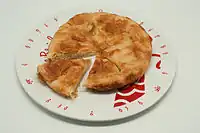kouign-amann
English
WOTD – 21 July 2022
Etymology


Traditionally, kouign-amann are baked in a large cake and served in slices (top), but it has become popular to prepare them as individual pastries (bottom).
Borrowed from Breton kouign-amann, from kouign (“brioche; bun; cake”) (ultimately from Latin cuneus (“wedge”), from Proto-Indo-European *h₂eḱ- (“sharp”)) + amann (“butter”) (ultimately from Proto-Indo-European *h₃engʷ- (“to anoint; to smear”)).
Pronunciation
- (Received Pronunciation) IPA(key): /ˌkwiːn æˈmæn/, /-ˈmɑn/
Audio (Southern England) (file) - (General American) IPA(key): /ˌkwin æˈmæn/, /-ˈmɑn/
- Rhymes: -æn
Noun
kouign-amann (countable and uncountable, plural kouign-amann or kouign-amanns)
Translations
traditional Breton cake made of layers of butter, dough, and sugar
|
Further reading
 kouign-amann on Wikipedia.Wikipedia
kouign-amann on Wikipedia.Wikipedia
Breton
Pronunciation
- IPA(key): /ˌkuɲ ˈamãnː/
Descendants
- → English: kouign-amann
- → French: kouign-amann
French
Pronunciation
- IPA(key): /kwi.ɲa.man/, /kwi.nja.man/, /ku.ɲa.man/, /ku.nja.man/
- Rhymes: -an
This article is issued from Wiktionary. The text is licensed under Creative Commons - Attribution - Sharealike. Additional terms may apply for the media files.